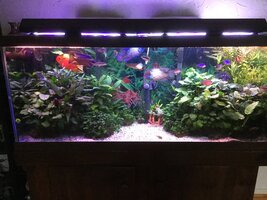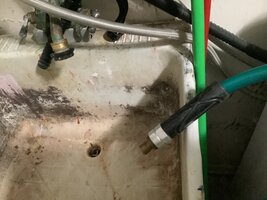Question on initial water changes for a new low-tech minimal planted set-up.
Firstly, this is not a primary aquascape tank for plants but for Cichlids and I am not following a Biotope approach. Plants will all be Java's and Anubias varieties that will be an experiment aka George Farmer and his Mbuna planted tank. Therefore, not planted in the substrate but fixed on root and rocks as I appreciate the benefit plants add to a tank visually and water quality. With the caveat of the additional fine tuning, maintenance and experience as I have learnt.....or not!
As I have yet to start my first real nature aquarium as intended I have been side-tracked to get this tank completed but had issues with first attempt with algae and dying plants. Anyway, I have stripped back and re-arranged my hardscape ready to be replanted. As a side note I have decided to undertake a fishless cycle first (yes using ammonia and bottle bacteria.....I have seen the posts on this) before I introduce the plants with hopefully fish a few weeks later once I am happy the plants are behaving themselves.
But to the point of my question is after planting (noting minimal and low-tech and not using an active substrate with potential ammonia leach) is there a need to undertake such high volume water changes daily as advised with such a set-up? My thoughts are this would not be as necessary in these circumstances noting that the tank would have cycled first and the low level of planting. Everything I have seen or read talks about water change every day (some say 30%, others 50% or higher) for the first week and then scaled down over a six week period. Don't get me wrong in that it would not be a bad thing but not sure if this would be required and a less intensive water change frequency would be adequate.
Advice greatly appreciated.
Firstly, this is not a primary aquascape tank for plants but for Cichlids and I am not following a Biotope approach. Plants will all be Java's and Anubias varieties that will be an experiment aka George Farmer and his Mbuna planted tank. Therefore, not planted in the substrate but fixed on root and rocks as I appreciate the benefit plants add to a tank visually and water quality. With the caveat of the additional fine tuning, maintenance and experience as I have learnt.....or not!
As I have yet to start my first real nature aquarium as intended I have been side-tracked to get this tank completed but had issues with first attempt with algae and dying plants. Anyway, I have stripped back and re-arranged my hardscape ready to be replanted. As a side note I have decided to undertake a fishless cycle first (yes using ammonia and bottle bacteria.....I have seen the posts on this) before I introduce the plants with hopefully fish a few weeks later once I am happy the plants are behaving themselves.
But to the point of my question is after planting (noting minimal and low-tech and not using an active substrate with potential ammonia leach) is there a need to undertake such high volume water changes daily as advised with such a set-up? My thoughts are this would not be as necessary in these circumstances noting that the tank would have cycled first and the low level of planting. Everything I have seen or read talks about water change every day (some say 30%, others 50% or higher) for the first week and then scaled down over a six week period. Don't get me wrong in that it would not be a bad thing but not sure if this would be required and a less intensive water change frequency would be adequate.
Advice greatly appreciated.







